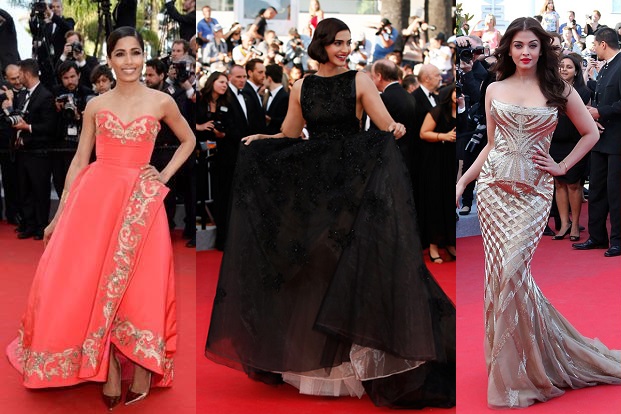
Four years ago in New York City I went to watch a film with a few girlfriends and thought of it as just another outing with buddies until I entered the theater. The hall was packed with teen girls, college females and career women who took a sharp departure from “Bargain Tuesdays” attire — heels were higher, handbags were fancier and accessories were on trend. Friends were posing for photos, aisles had become quasi-red carpets, and there was much chatter regarding the leading lady. All this excitement was in anticipation of the Sonam Kapoor-starrer, Aisha.
The audience ooh’ed and ahh’ed during the film’s shopping spree at the posh DLF Emporio mall, rattled off names of European luxury brands worn by the heroine, and made mental notes of the non-traditional styling of traditional Indian wear. Going by the conversations I heard before and after the screening, many were completely prepared for style stomping substance (i.e., writing, direction, acting) with a red-bottomed Louboutin heel. But this moment in pop culture was much greater than showcasing expensive clothing. Sonam Kapoor’s character simultaneously played to the aspirations of the moviegoers and reflected how many saw themselves: multicultural, fashion conscious, cosmopolitan women.
Hindi film idols have always provided on-screen fashion inspiration to the masses and given many tailors the task of making the “girl next door” into the “Dream Girl” seen on the silver screen. But off screen not much was expected from cinema stars’ sartorial choices. The Filmfare Award shows paraded actresses in saris chosen by the same handful of Indian designers year after year, and actors usually wore ill-fitting suits or blue jeans. Whenever asked about their favorite designers, stars mentioned Armani or Versace, proving their fandom by wearing t-shirts with logos of the aforementioned names loudly emblazoned across their chest. Further adding to the perception of the Hindi film industry as the bastion of bad taste, Aishwarya Rai Bachchan, often referred to as the most beautiful woman in the world, was unanimously slammed by the Indian media for her atrocious ensembles at the 2002 Cannes Film Festival.
On the other side of the world, actresses like Sarah Jessica Parker and Jennifer Lopez were garnering global attention as style icons while being in the news for their work in successful television and film projects. But not all starlets could rise to such incredible heights. So how was a girl to stay relevant in Hollywood? Keira Knightly, Kate Bosworth, Emmy Rossum, and especially Blake Lively, actresses who also came into the limelight via film and television, stayed in the public eye in a new avatar: the fashionista. Style became a substitute for box office success, even acting ability, while magazine covers became akin to film posters. Blogs scrutinizing clothing choices provided testimony to an actress’ popularity. A new kind of celebrity was born.
It was only a matter of time before a similar model was adopted in India. Incredible new wealth being generated in India Inc., the aspirational Indian youth who grew up in post-liberalization, and rapidly sharing information and communicating via the internet made fertile ground for budding celebrity fashionistas. Aishwarya and Freida Pinto became global ambassadors for cosmetic giant L’Oreal, making the possibility of an Indian actress becoming a global style icon believable and achievable.
#AishwaryaRai #FreidaPinto leave their fans stunned in latest @LOrealParisUSA star-studded ad http://t.co/M0liKB4gBn pic.twitter.com/u5g9rSlQ25
— Shruti Srivastava (@Shrutz_iluvme) September 20, 2014
Box office failures, poor reviews of her performance, and the impression of being left in the dust by uber-successful heroines made Indian actress Sonam Kapoor a prime candidate for a most unique Hollywood formula. Her father, Hindi film actor Anil Kapoor, saw first-hand how his Slumdog Millionaire co-star Frieda Pinto was garnering much publicity for her impressive red carpet appearances. Team Sonam, which included fashion stylists, then a novelty in tinsel town, kicked into action. Rather than playing safe with more known brands such as Armani, Miss Kapoor was photographed in Vivienne Westwood, Chloe, and Alexander McQueen. Instead of dressing in an ensemble designed by Manish Malhotra like many leading ladies, Sonam tweeted ornate Anamika Khanna creations. While many in the Hindi film industry were unsure of how to effectively use social media, she Instagramed geek chic, intricate braids and posed with high-fashion accessories straight out of Paris Fashion Week.
In @dolcegabbana to launch my #Septemberissue of @vogueindia at #fno !! Thank you @anait… http://t.co/tkGfj2AALL pic.twitter.com/jJEBKvMZFx — Sonam Kapoor (@sonamakapoor) September 5, 2014
She may not have appeared on many film posters, but she was certainly on the cover of Vogue, Elle and Harper’s Bazaar, to name a few. By tearing out a page from the Hollywood starlet manual of maintaining an acting career by staying in the news as a full-fledged fashionista Sonam Kapoor has become a brand to reckon with. Referred to as India’s leading style icon, she owes a sizable share of her popularity to entertainment and style blogs, social media platforms such as Twitter and Instagram, and fashion magazines. Sonam has proved public appearances are public relations opportunity and a moment to manufacture a dream outside the confines of a movie theater. Now all leading Hindi film actresses have bought a ticket to board the best-dressed bandwagon.
Thankfully, the awareness of luxury brands based outside of India hasn’t strengthened the perception of “West Is Best” when it comes to clothing and accessories. Both established and up-and-coming fashion designers are being celebrated and receiving much deserved attention for their originality and craftsmanship. It certainly helped that designers who honed their craft in India such as Manish Aurora, Prabal Gurung, and Falguni and Shane Peacock made a name for themselves outside of the subcontinent. These artists not only proved to the ex-India audience that South Asia is brimming with talent, but also made known that excellence in vision and execution knows no borders.

Indian film heroines have come a long ways since Aishwarya’s appearance at Cannes 12 years ago. The 2014 festival witnessed Sonam in Elie Saab, Freida in Oscar de la Renta and Aishwarya making a stunning comeback in Roberto Cavalli. And unlike salaries and screen time, which undoubtedly favor the male sex, style watchers do not discriminate between actors and actresses. Leading men are now seen in tailored Tom Ford suits and sleek Rohit Bal sherwanis, while their casual wear resembles that of a hip, well-traveled individual whom the youth in Indian towns can aspire to be.
For the past four to five years what film celebrities wear off-screen is being just as, if not more, scrutinized than fashions they don in films. The new game is about a keen awareness of global trends, creating an image, and portraying a sense of taste and style without becoming a fashion victim. Hindi cinema has entered an era where actors and actresses are not only seen as artists or entertainers, but as brands which are shaped by both their on screen and off screen personas. Style now is about much more than the now often posed question: “Who wore it better?” It’s about drawing inspiration from far and wide while expressing a unique identity and projecting pride. It means standing toe-to-toe with colleagues from around the world and representing the biggest film industry in the world.
Shivani cannot remember a time when she wasn’t madly in love with Indian cinema, which now inspires much of her writing. She lives in both New York City and Twitterpur at @Shivani510.













Thank you Shivani for that in depth look at fashion and how it can sometimes “make or break” a celebrity! Sometimes it’s all in “how you play the game,”.. aka Sonam Kapoor.
Looking forward to your next piece!